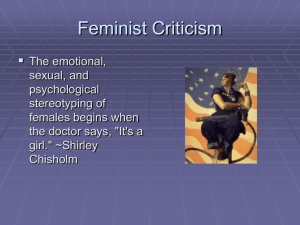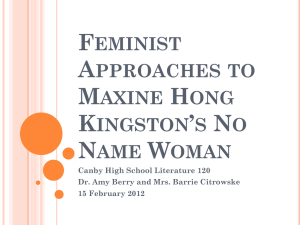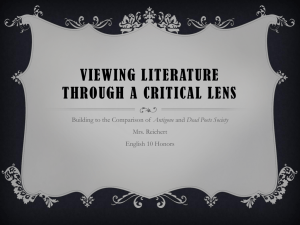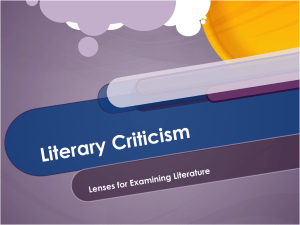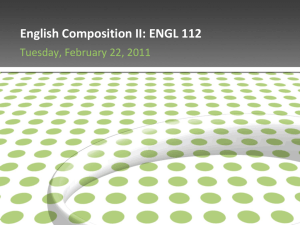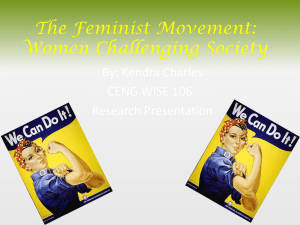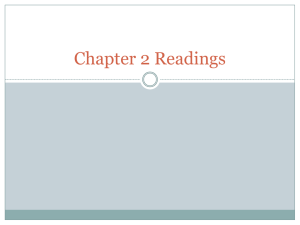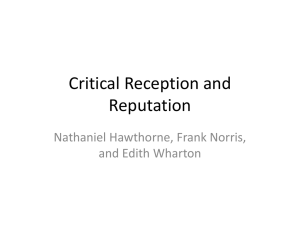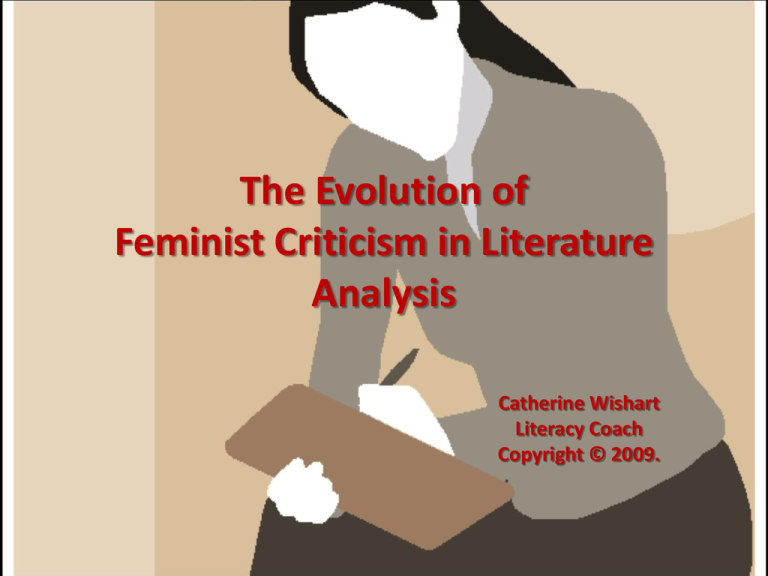
The Evolution of
Feminist Criticism in Literature
Analysis
Catherine Wishart
Literacy Coach
Copyright © 2009.
What is Feminist Criticism?
• Women continue to search for their own voice and power
base:
– Sojourner Truth fought for freeing slaves and then for freeing
women.
– Suffragettes fought for the right to vote.
– After WW II, women fought to continue working once troops
came home.
– Women continue to fight for and debate specific women’s
issues:
• Should a mother work outside the home?
• Should women have the right to abort?
• How can women protect themselves from domestic abuse?
• Exploring these issues is often possible when examining
literature closely.
• Feminist criticism is “concerned… with the status of
women” (Lynn 229).
Key Terms in Feminist Theory
• Canon: “that group of works that are usually
reprinted, read, assigned, written about, and
taken most seriously” (Lynn 261).
– European male authors over-represented.
– Female authors under-represented.
• Double –voiced: write with two voices so
societal norms are not threatened, but other
perspectives are explored (Lynn 262).
• Sexist: “Pejorative characterizations of women
as a group” (Lynn 263).
• Gender: “cultural aspects of sexuality” (Lynn 262).
What Does Feminist Criticism Examine?
• Feminist Criticism reads a text closely to determine
what is said about:
–
–
–
–
Sexual oppression
Personal freedom
Social justice
Stereotyping
• Includes examining how men are stereotyped
• Feminist Criticism wants to pursue:
– Equality for women
– Reasons for oppressive behaviors
– Revealing texts that use double-voice to continue to
subjugate women
(Lynn 229)
Practicing Feminist Criticism
• Carefully read the story on the next slide.
• Consider the role of Boori Ma in the story.
• What questions come to mind about Boori Ma’s
situation?
• Think about these questions when reading:
– Why is Boori Ma called “the sweeper of the
stairwell”?
– How does her age play into her situation?
– Does her gender add difficulties for her? If so, how?
A Real Durwan
Boori Ma, sweeper of the stairwell, had not slept in two nights. So the
morning before the third night she shook the mites out of her bedding.
She shook the quilts once underneath the letter boxes where she
lived, then once again at the mouth of the alley, causing the crows
who were feeding on vegetable peels to scatter in several directions.
As she started up the four flights to the roof, Boori Ma kept one hand
placed over the knee that swelled at the start of every rainy season.
That meant that her bucket, quilts and the bundle of reeds which
served as her broom all had to be braced under one arm. Lately Boori
Ma had been thinking that the stairs were getting steeper; climbing
them felt more like climbing a ladder than a staircase. She was sixtyfour years old, with hair in a knot no larger than a walnut, and she
looked almost as narrow from the front as she did from the side.
Interpreter of Maladies,Jhumpa Lahiri
Evolving Into Post-Feminism
• Post-feminists generally believe that
feminism has done its job – equal rights is
occurring in most first world countries.
• There are still important issues facing
women:
– What are the “distinctive needs” of women?
• Childrearing, housecleaning still considered “women’s
work”
• Why are these duties considered female? How do
these duties impede on women’s progress in society?
(Lynn 229-30).
Practicing Post-Feminist Criticism
• Many shows of the 50s and 60s portrayed
women in particular roles.
• In the attached clip, the daughter of Donna
Reed in The Donna Reed Show, Mary Stone,
is looking for her identity.
• What does this search say about women’s
roles and needs?
• Click on the movie camera to view the clip.
The Evolution of Women’s Voices in
Literature
Traditional Canon: women’s
voices/rights/needs generally
ignored
Feminist Criticism: women’s
rights and oppression studied
closely
Post-Feminist Criticism: women’s
specific needs examined – move
towards diversity, not dualism
References and Suggested Reading
• Donna Reed Show with Shelly Fabares. You Tube.
http://www.youtube.com/watch?v=qpSow6Jy7ms (referenced).
• “Feminist Criticism.” The Cambridge Guide to Literature in English.
Cambridge: Cambridge U P, 2000 (suggested reading).
• Gardiner, Anne Barbeau. “Feminist literary criticism: from antipatriarchy to decadence.” Modern Age 49.4 (Fall 2007): 393(7)
(suggested reading).
• Greene, Gayle. Changing the Story: Feminist Fiction and the
Tradition. Bloomington, IL, 1991 (suggested reading).
• Lahiri, Jhumpa. “A Real Durwan. Interpreter of Maladies. New
York: Houghton Mifflin Harcourt. 70-82. (referenced text).
• Lynn, Steven. “Gendering the Text: Feminist Criticism, PostFeminism, and Queer Theory.” Texts and Contexts: Writing about
Literature with Critical Theory. New York: Pearson Longman, 2008.
227-66. (referenced text).


